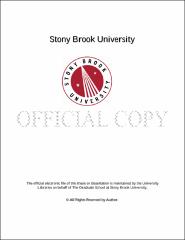| dc.identifier.uri | http://hdl.handle.net/11401/77169 | |
| dc.description.sponsorship | This work is sponsored by the Stony Brook University Graduate School in compliance with the requirements for completion of degree. | en_US |
| dc.format | Monograph | |
| dc.format.medium | Electronic Resource | en_US |
| dc.language.iso | en_US | |
| dc.publisher | The Graduate School, Stony Brook University: Stony Brook, NY. | |
| dc.type | Dissertation | |
| dcterms.abstract | Nitric Oxide (NO) is a diatomic signaling molecule that regulates diverse bacterial behaviors. Its effect on cell motility has been established in many microbial systems, but the molecular mechanism remains understudied. Some bacteria have an H-NOX (Heme-Nitric oxide/OXygen-binding) domain that functions as an NO sensor. It is found in the same operon with two component signaling histidine kinases or diguanylate cyclases (DGC) that synthesize and degrade cyclic di-GMP (c-di-GMP). C-di-GMP is a secondary signaling molecule that regulates bacterial motile to sessile lifestyle transition. In this dissertation, we dedicated our effort toward understanding the effect on bacterial biofilm by NO/H-NOX regulated signaling pathway. In <italic>Vibrio harveyi</italic>, NO mediates quorum sensing (QS) through the H-NOX/HqsK pathway. We show that NO regulates flagellar production and biofilm formation in a concentration dependent manner. At low nanomolar concentration of NO, repression of flagellin coincides with enhanced biofilm. As NO concentration increases (100~200nM), a global switch takes place in protein expression and results in decreased flagellar production and less promotion of biofilm. In <italic>Shewanella woodyi</italic>, H-NOX binds a bifunctional DGC (SwHaCE). Nanomolar levels of NO repress biofilm formation through c-di-GMP degradation, and enhance phosphodiesterase activity of <italic>Sw</italic>HaCE, leading to c-di-GMP hydrolysis. H-NOX regulation is not limited to iv proteins in the same operon. <italic>Sw</italic>H-NOX can also interact with <italic>Vh</italic>HqsK homologue, <italic>Sw</italic>HK (Swoo_2833). Weaker biofilm phenotype in response to NO is attenuated when SwHK gene is disrupted in <italic>S. woodyi</italic>. In summary, NO mediates biofilm formation and protein expression via binding sensor protein H-NOX in multiple systems. Since biofilm is the predominant form of bacteria in natural aquatic environment, revealing the NO signaling mechanism would facilitate further understanding of bacterial group behavior. | |
| dcterms.available | 2017-09-20T16:52:08Z | |
| dcterms.contributor | Tonge, Peter | en_US |
| dcterms.contributor | Boon, Elizabeth M | en_US |
| dcterms.contributor | Schärer, Orlando | en_US |
| dcterms.contributor | Walker, Stephen. | en_US |
| dcterms.creator | Xu, Yueming | |
| dcterms.dateAccepted | 2017-09-20T16:52:08Z | |
| dcterms.dateSubmitted | 2017-09-20T16:52:08Z | |
| dcterms.description | Department of Chemistry. | en_US |
| dcterms.extent | 128 pg. | en_US |
| dcterms.format | Monograph | |
| dcterms.format | Application/PDF | en_US |
| dcterms.identifier | http://hdl.handle.net/11401/77169 | |
| dcterms.issued | 2015-08-01 | |
| dcterms.language | en_US | |
| dcterms.provenance | Made available in DSpace on 2017-09-20T16:52:08Z (GMT). No. of bitstreams: 1
Xu_grad.sunysb_0771E_11958.pdf: 4657628 bytes, checksum: 1dd8b19d158df18cdb799f2a8611435b (MD5)
Previous issue date: 2014 | en |
| dcterms.publisher | The Graduate School, Stony Brook University: Stony Brook, NY. | |
| dcterms.subject | Chemistry | |
| dcterms.title | It's a NO for Bacterial Settlement: Nitric Oxide Regulated Biofilm Formation and Protein Expression | |
| dcterms.type | Dissertation | |

